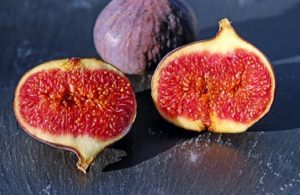If you’ve ever eaten a fig before, raise your hand. If that fig was in a cookie form (you know which one what I’m talking about), put your hand down. I thought so. The majority of people in this country have never eaten a plain fresh or dried fig. So you might not know that both types of figs are edible and awesome! 
Although categorized as a fruit, the fig is actually a flower that has inverted into itself. The seeds are drupes, or the real fruit. One of fig’s claims to fame is that it is one of the few fruits still allowed to fully ripen on the tree (for ultimate sweetness), before falling to the ground to continue drying. Most other dried fruits, like raisins and prunes, are dried under climate-controlled conditions.
Fresh figs are found in the produce section, but tend to be rare because they are so delicate and perishable. As such, they should be kept refrigerated. Their skin is fragile, and often scars during the growing period from the leaves rubbing against the fruit. Those marks do not hurt the flesh inside. Recommended storage temperatures range from 32 to 36 degrees F or 0 to 2 degrees C. Use fresh figs as soon as possible. Under ideal conditions, they will keep from 5-7 days, or up to six months frozen in a sealed bag or container.
Dried figs are generally found in the produce and/or baking section of your favorite supermarket. They are more readily available and therefore more convenient. Dried figs will last six months if unopened, but once opened, should be stored in an airtight container or refrigerated.
Figs are naturally fat-, sodium- and cholesterol-free. Just 3-5 figs provide the following amazing nutritional bonuses:
Dried (1/4 cup; 40 grams)
- 110 calories
- 5g fiber (20% of the Daily Value)
- 244mg potassium (7% of the Daily Value)
- 53mg calcium (6% of the Daily Value)
Fresh (1/2 cup; 3-4 medium figs)
- 120 calories
- 5g fiber (20% of the Daily Value)
- 354mg potassium (10% of the Daily Value)
- 53mg calcium (6% of the Daily Value)
Want to try figs, but are not sure where to start? Enjoy them raw or paired with a sharp cheese. Or try them dried, chopped, and mixed in oatmeal like this fig and honey oatmeal recipe. For a twist on your holiday cranberry sauce, combine figs with cranberries to make fig cranberry relish. Or be adventurous and fix a warm quinoa salad with wilted kale and figs.
Fresh figs can be stewed or added to a salad. Stuff them with a sharp hard cheese like Manchego and bake them. Tired of peanut butter or avocado toast? Try fig toast! But definitely make an effort to add this unique food to your “fruit” repertoire!
www.fruitsandveggiesmorematters.org

